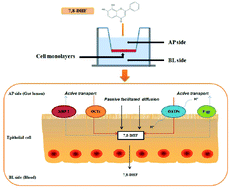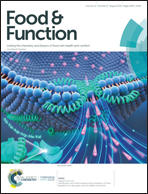Transepithelial transport mechanisms of 7,8-dihydroxyflavone, a small molecular TrkB receptor agonist, in human intestinal Caco-2 cells†
Abstract
7,8-Dihydroxyflavone (7,8-DHF), as a high-affinity TrkB receptor agonist, has been extensively explored in many human disorders involving brain-derived neurotrophic factor (BDNF) such as Alzheimer's disease, Parkinson's disease, depression, and obesity. However, to date, the transepithelial transport mechanisms of 7,8-DHF in the intestines remain unclear. The aim of our work was to quantify and to characterize in vitro transport of naturally occurring 7,8-DHF distinguished by its physicochemical and pharmacological properties. We discussed the transport mechanisms of 7,8-DHF using the Caco-2 cell model to determine the bi-directional permeability with different environmental factors (time, concentration, pH, metabolic inhibitors etc.). The influx and efflux characteristics of 7,8-DHF were also clarified. 7,8-DHF was poorly transported across Caco-2 cell monolayers by mainly passive diffusion via a transcellular pathway and not a paracellular pathway. The transport of 7,8-DHF was time and concentration-dependent in both the apical (AP) to basolateral (BL) side and the reverse direction. Interestingly, decreasing the pH from 7.4 to 6.0 markedly enhanced 7,8-DHF transport. It is noteworthy that 7,8-DHF transport was strongly inhibited by metabolic inhibitors and was highly dependent on temperature. The efflux ratio (ER) values at different concentrations were all above 1.5, indicating the existence of the efflux transporter. We found that breast cancer resistance protein (BCRP) was not involved in 7,8-DHF secretion and that the transport mechanism of 7,8-DHF was passive transport with an active efflux mediated by P-glycoprotein (P-gp) and multidrug resistance associated proteins (MRPs), particularly MRP 2. Moreover, the use of various influx transporter inhibitors in Caco-2 cells showed that organic cation transporters (OCTs) and organic anion-transporting polypeptides (OATPs) participated in 7,8-DHF transport. Taken together, the elucidated transport characteristics of 7,8-DHF provide useful information for designing novel and efficient delivery systems and avoiding food–food or food–drug interactions.



 Please wait while we load your content...
Please wait while we load your content...